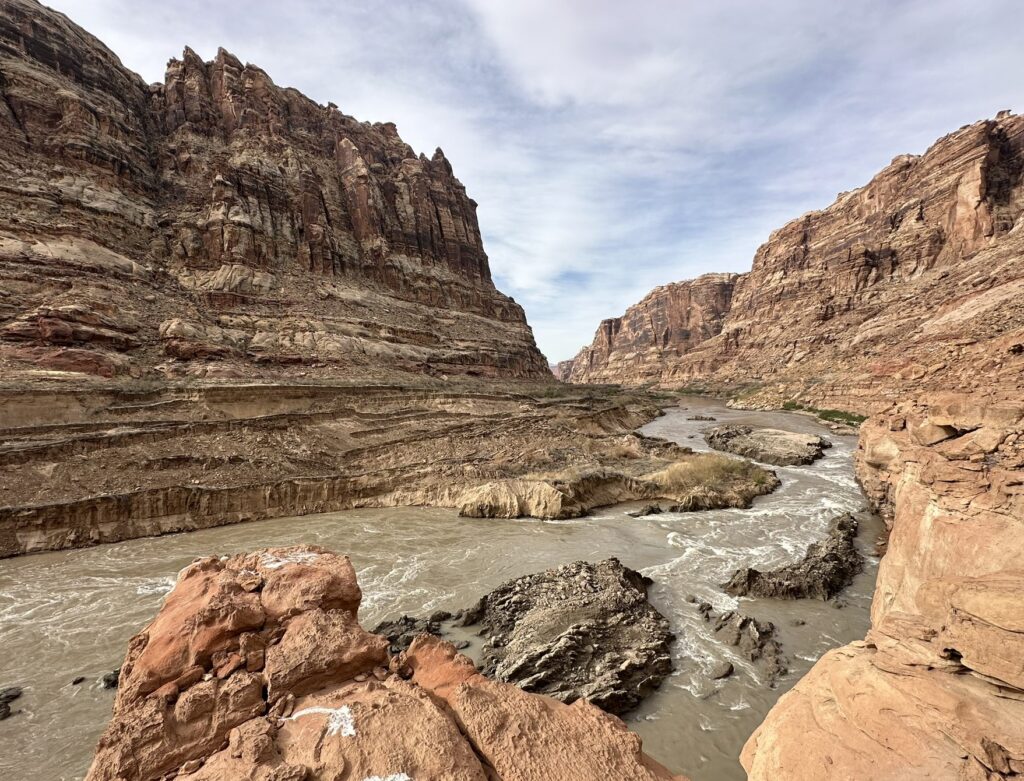A sediment slump roughly the size of City Market has slid into the Colorado River in the lower portion of Cataract Canyon.
The slump is located around river mile 175 within the segment called Narrow Canyon and was first reported to the Returning Rapids Project by Davide Ippolito, who encountered the slump on October 29 on a private river trip.

Ippolito is a project researcher for Returning Rapids, a group that “brings together researchers, scientists, river runners, and journalists to study the changes and share the story of the Colorado and San Juan Rivers as they recover from Glen Canyon Dam,” as stated on their website.
Mike DeHoff, principal investigator for RRP said that Ippolito contacted him to inform him of the new rapid when Ippolito first received cell service on Powell Reservoir, which is located below the rapids of Cataract Canyon and above the Glen Canyon Dam. DeHoff then contacted Canyonlands National Park, who issued a press release on November 1 stating that “Approximately 300-350 meters of shoreline slid from the river-left bank into the river channel” and created “a new small rapid.”
Since then, the rapid, now referred to as Fishmouth Slump due to its proximity to Fishmouth Cave, has undergone a series of changes. Additional documentation was submitted to RRP from one of their original project researchers, Chris Benson, who was there with the US Geological Survey Water Science Center and the Park Service to service the water gage at Gypsum Rapid. The group was camped below the rapid on November 6.
“In the middle of the night we all seemed to notice that the noise coming from the rapid seemed to increase,” Benson states in his YouTube video posted on November 11 titled “Mud Rapid.”
“Just before going to bed, we also noticed the water levels where we camped were changing. When we woke up there was quite a bit of foam in the main current as well as floating sticks and debris.” The group motored back up to the rapid the following morning and identified that the rapid had intensified.
DeHoff has reason to believe that the slump temporarily dammed the river. “The water level went down 10 inches on them for a short period of time and then came back up. Why else would that happen?”
The rapid was reported to evolve yet again by a group of private boaters who took out on November 19. They described a Class IV rapid with three channels: the left channel containing a series of holes including a ledge hole, as well as a giant lateral wave and a wave train; the middle channel being clear but containing a big wave train that leads to a bend around a corner with swift flat water; and the right channel being tight but runnable.
DeHoff observed the rapid from satellite imagery and perceived an increase in the presence of whitewater, which indicates a rapid. This observation was too compelling to ignore so he and his wife Meg Flynn, who is also a fellow project researcher, motored up Narrow Canyon from the Northwash Boat Ramp on November 23.
“The report from [the November 19] party is different from what was observed on November 23…Clearly the river is eroding the sediment away and the rapid is very dynamic,” RRP wrote.
The cause of the rapid is unclear, but Benson supposes that the inch of precipitation that fell in the area on October 18 may have influenced the event. Cooling temperatures could also be a consideration. The Returning Rapids Project urges people to take the following precautions when traveling through Cataract Canyon:
“Please remember that it is a good practice to wear your lifejacket until you get to blue water. If traveling in a multiple boat motor rig, it is a good practice to rig your flotilla in such a way that it can be easily, and quickly, broken apart. Staying aware and paying attention helps keep you safe in this dynamic environment.” The rapid can be scouted on river-right at the sandstone ledge.
This is not the first significant mud rapid to develop in Cataract Canyon. In July of 2023, a temporary rapid called “Space Slump” formed, which was surveyed at 1.3 million cubic meters of sediment that had moved from river left, pushing the river channel to the right. The rapid received its name due to the fact that the slump could be observed from satellite imagery.
In its Fall Findings Report, the group hypothesized that the rise and fall of the reservoir caused a wetting and re-wetting of the slump, which destabilized it. There is also a spring there that helped destabilize the bank. The spring has created a large pool perched in the mud slump. It is believed that the slump occurred in the afternoon. Mud and debris were observed high above the waterline on river right, suggesting that the slump was sudden and impactful.
According to a report published by the USGS in 2003, it is estimated that 65 million tons of sediment would travel the Colorado River prior to reaching the Grand Canyon before the Glen Canyon Dam was built. The dam, located above the Grand Canyon, was completed in 1966, inhibiting the natural flow of sediment. The sediment collects behind the dam in Powell Reservoir and has created a geological layer called the Dominy Formation, a name that credits the massive sediment deposit to the Commissioner of Reclamation seated during the dam’s construction, Floyd Dominy.
How much of the Dominy Formation that is exposed is contingent on the water level of the reservoir.
“The overall sediment delta combining the part that’s above the water level and the part that’s below the water level on the Colorado [River] arm is somewhere between 40 and 45 miles long,” DeHoff said. He estimates that there are approximately 20 miles of Dominy Formation in Cataract Canyon, noting that of the 41 miles that comprise that stretch of river, only 16 miles were not inundated by Powell Reservoir.
The slumps are expected to be a recurring event.
“It’s happening on smaller scales everywhere in Cataract right now,” DeHoff said. “Instead of the size of a City Market building, it’s more like the size of a small house or storage shed. I would bet that there’s a sizable slump every mile in Cataract right now, but these mega slumps are something to see.”
“I never thought we’d end up studying so much sediment,” DeHoff said. “We’ve kind of figured out that beside the reservoir level, the main thing preventing rapids from coming back is the sediment.”
Sediment is also responsible for the river shifting its channel, which can create rapids that cannot be safely run by boaters when the river channel cuts through the sediment and reaches a cliff in the bedrock.
This can be seen with the Pearce Ferry Rapid just below the Pearce Ferry Boat Ramp located by the Grand Wash Cliffs of the Grand Canyon and is predicted to occur above the Northwash Boat Ramp of Cataract Canyon.
“If someone goes and clear-cuts a forest near your home or mines gold from the hills near your house and leaves a big tailings pile, there are laws that force remediation, but there are not on the Colorado River,” DeHoff said. “The sediment is like the tailings pile of mining the Colorado River water.”
The implications of the sediment are complex and are gaining attention from journalists, researchers and scientists. Currently, no government agencies are claiming responsibility for the sediment or for how to manage it.
River runners are encouraged to submit descriptions and photographs of any changes they observe at Fishmouth Slump or elsewhere in Cataract Canyon and the San Juan River. The Returning Rapids Project archives data and strives to communicate accurate and up-to-date information. Observations can be submitted at their website, returningrapids.com, or via email at contact@returingrapids.com.




